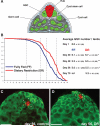Dietary restriction enhances germline stem cell maintenance
- PMID: 20569233
- PMCID: PMC2944899
- DOI: 10.1111/j.1474-9726.2010.00602.x
Dietary restriction enhances germline stem cell maintenance
Abstract
Dietary restriction (DR) increases lifespan in species ranging from yeast to primates, maintaining tissues in a youthful state and delaying reproductive senescence. However, little is known about the mechanisms by which this occurs. Here we demonstrate that, concurrent with extending lifespan, DR attenuates the age-related decline in male germline stem cell (GSC) number in Drosophila. These data support a model whereby DR enhances maintenance of GSCs to extend the reproductive period of animals subjected to adverse nutritional conditions. This represents the first example of DR maintaining an adult stem cell pool and suggests a potential mechanism by which DR might delay aging in the tissues of higher organisms.
© 2010 The Authors Aging Cell © 2010 Blackwell Publishing Ltd/Anatomical Society of Great Britain and Ireland.
Figures


Similar articles
-
The functional costs and benefits of dietary restriction in Drosophila.Aging Cell. 2007 Feb;6(1):63-71. doi: 10.1111/j.1474-9726.2006.00261.x. Aging Cell. 2007. PMID: 17266676
-
Lifespan extension by dietary restriction in female Drosophila melanogaster is not caused by a reduction in vitellogenesis or ovarian activity.Exp Gerontol. 2004 Jul;39(7):1011-9. doi: 10.1016/j.exger.2004.03.018. Exp Gerontol. 2004. PMID: 15236760
-
The plate half-full: status of research on the mechanisms of dietary restriction in Drosophila melanogaster.Exp Gerontol. 2011 May;46(5):363-8. doi: 10.1016/j.exger.2010.12.002. Epub 2010 Dec 25. Exp Gerontol. 2011. PMID: 21187139 Free PMC article. Review.
-
Does dietary restriction really increase longevity in Drosophila melanogaster?Ageing Res Rev. 2005 Aug;4(3):409-21. doi: 10.1016/j.arr.2004.12.001. Ageing Res Rev. 2005. PMID: 16051527 Review.
-
Live imaging of the Drosophila spermatogonial stem cell niche reveals novel mechanisms regulating germline stem cell output.Development. 2011 Aug;138(16):3367-76. doi: 10.1242/dev.065797. Epub 2011 Jul 13. Development. 2011. PMID: 21752931 Free PMC article.
Cited by
-
Mesenchymal stem cells conditioned with glucose depletion augments their ability to repair-infarcted myocardium.J Cell Mol Med. 2012 Oct;16(10):2518-29. doi: 10.1111/j.1582-4934.2012.01568.x. J Cell Mol Med. 2012. PMID: 22435530 Free PMC article.
-
Ageing in Drosophila: the role of the insulin/Igf and TOR signalling network.Exp Gerontol. 2011 May;46(5):376-81. doi: 10.1016/j.exger.2010.09.003. Epub 2010 Sep 16. Exp Gerontol. 2011. PMID: 20849947 Free PMC article. Review.
-
Toward Elucidating Epigenetic and Metabolic Regulation of Stem Cell Lineage Plasticity in Skin Aging.Front Cell Dev Biol. 2022 May 19;10:903904. doi: 10.3389/fcell.2022.903904. eCollection 2022. Front Cell Dev Biol. 2022. PMID: 35663405 Free PMC article. Review.
-
Integrating physiological regulation with stem cell and tissue homeostasis.Neuron. 2011 May 26;70(4):703-18. doi: 10.1016/j.neuron.2011.05.011. Neuron. 2011. PMID: 21609826 Free PMC article. Review.
-
Ageing: A healthy diet for stem cells.Nature. 2012 Jun 27;486(7404):477-8. doi: 10.1038/486477a. Nature. 2012. PMID: 22739309 No abstract available.
References
-
- Angelo G, Van Gilst MR. Starvation protects germline stem cells and extends reproductive longevity in C. elegans. Science. 2009;326:954–958. - PubMed
-
- Boyle M, Wong C, Rocha M, Jones DL. Decline in self-renewal factors contributes to aging of the stem cell niche in the Drosophila testis. Cell Stem Cell. 2007;1:470–478. - PubMed
-
- Drummond-Barbosa D, Spradling AC. Stem cells and their progeny respond to nutritional changes during Drosophila oogenesis. Dev Biol. 2001;231:265–278. - PubMed
-
- Economos AC, Miquel J, Binnard R, Kessler S. Quantitative analysis of mating behavior in aging male Drosophila melanogaster. Mech Ageing Dev. 1979;10:233–240. - PubMed
-
- Fricke C, Bretman A, Chapman T. Adult male nutrition and reproductive success in Drosophila melanogaster. Evolution. 2008;62:3170–3177. - PubMed
Publication types
MeSH terms
Grants and funding
LinkOut - more resources
Full Text Sources
Medical
Molecular Biology Databases
Research Materials

